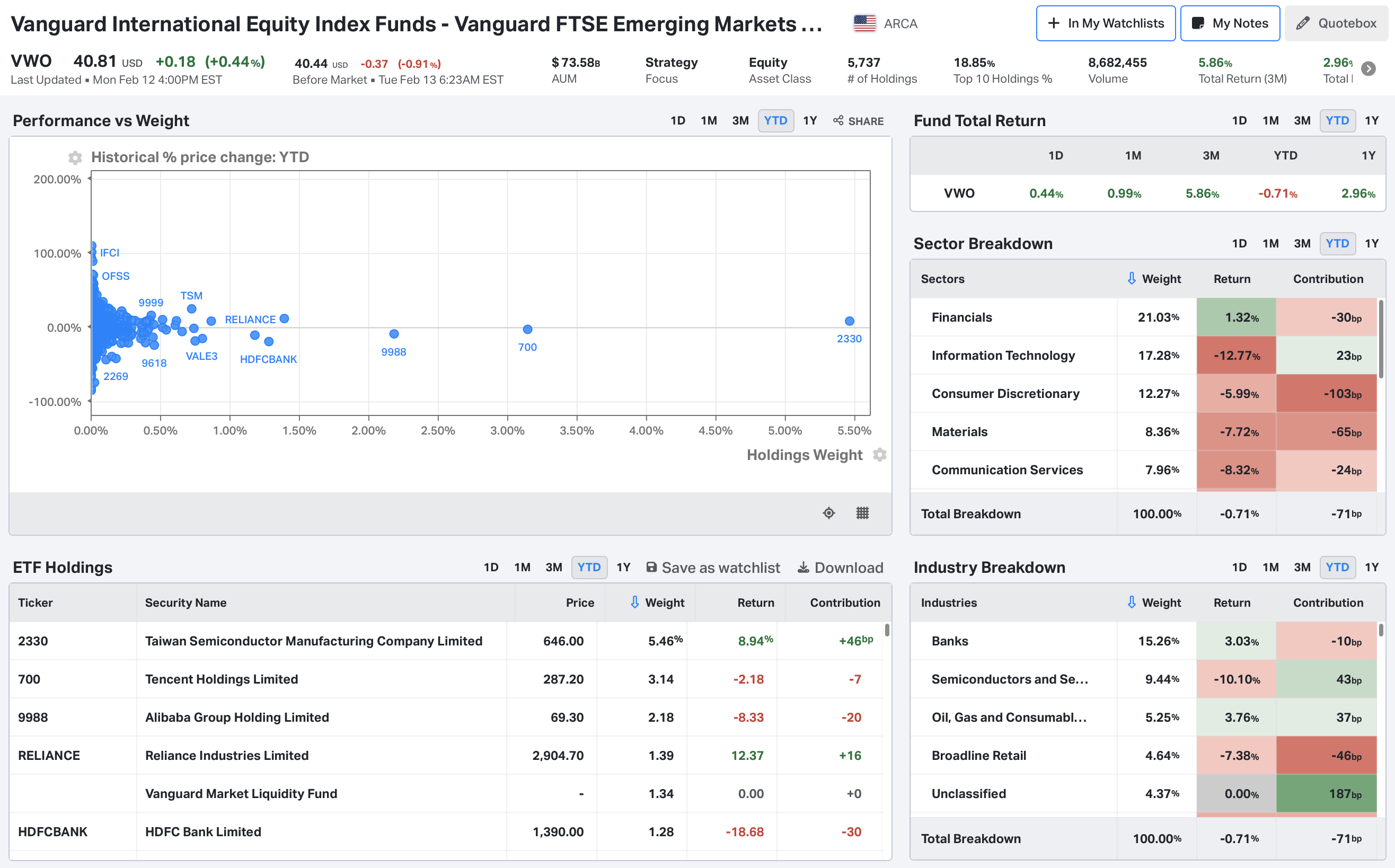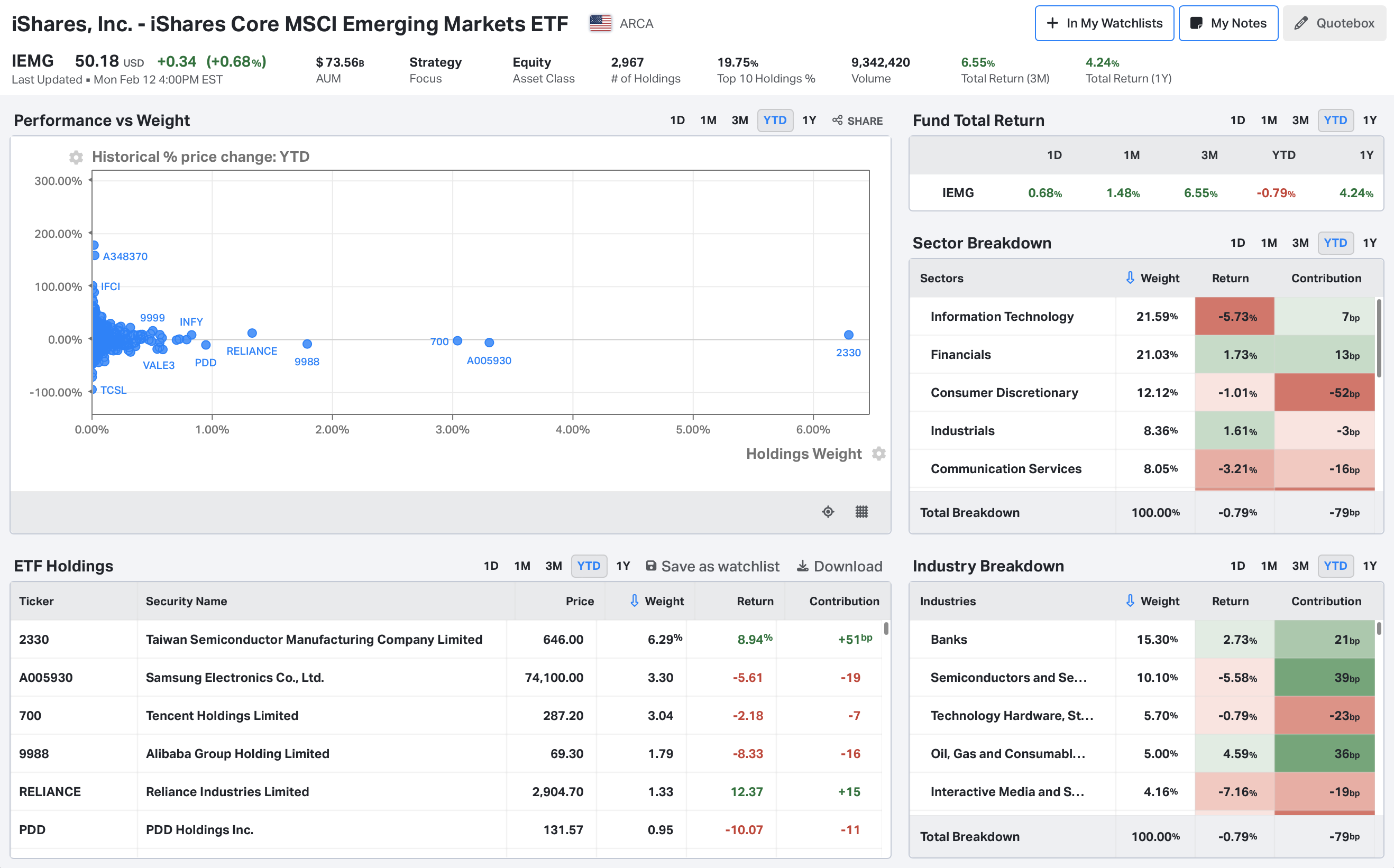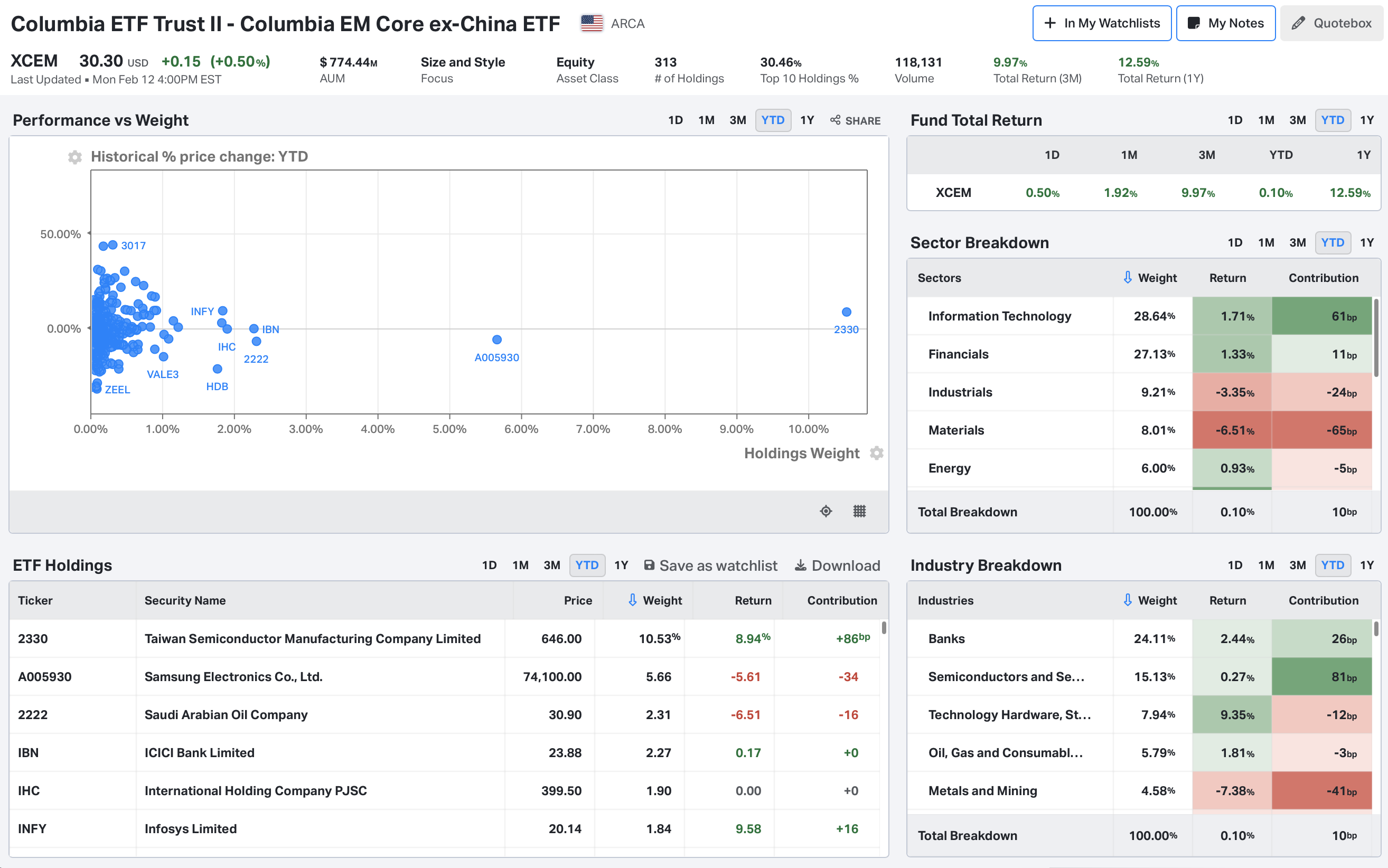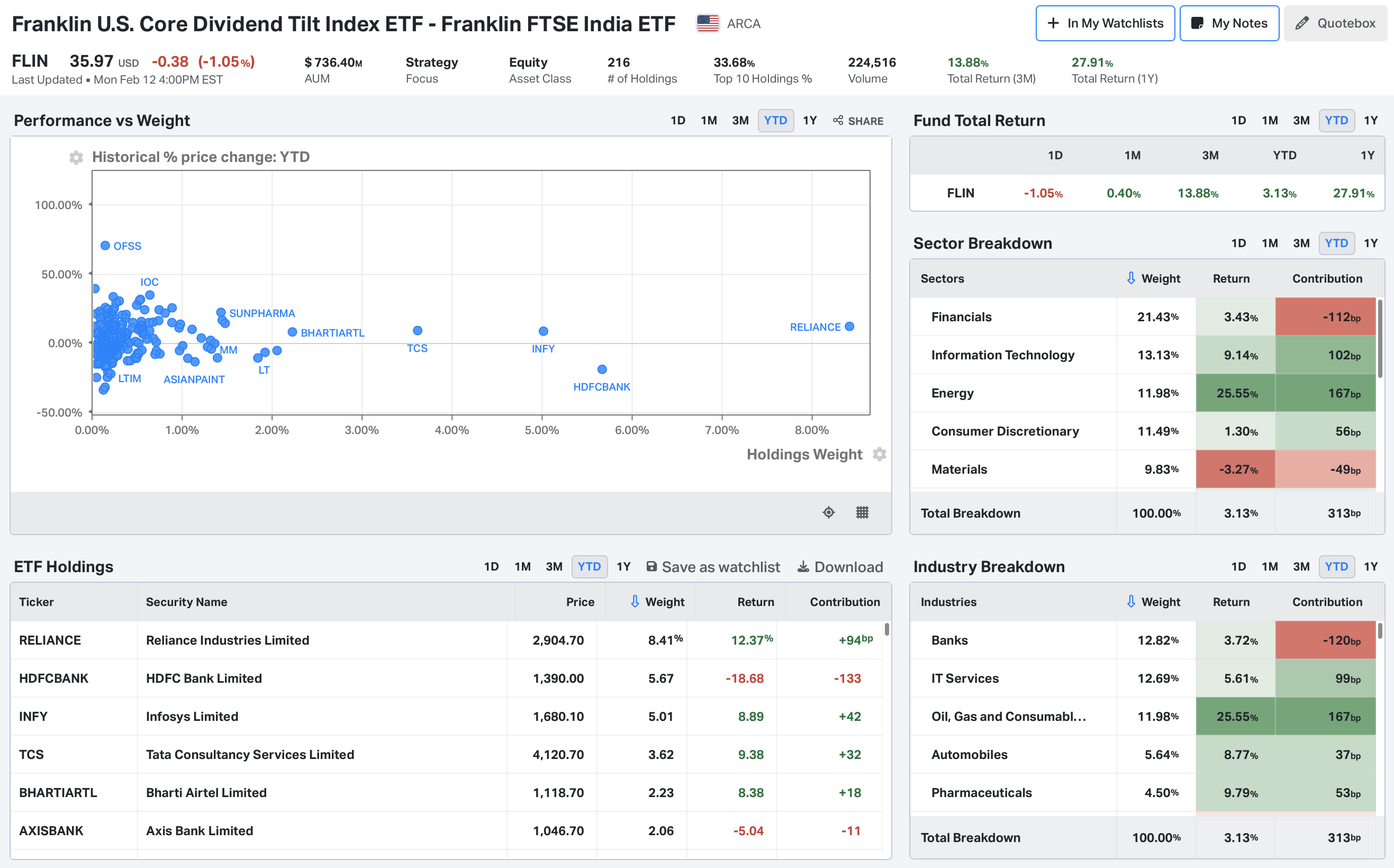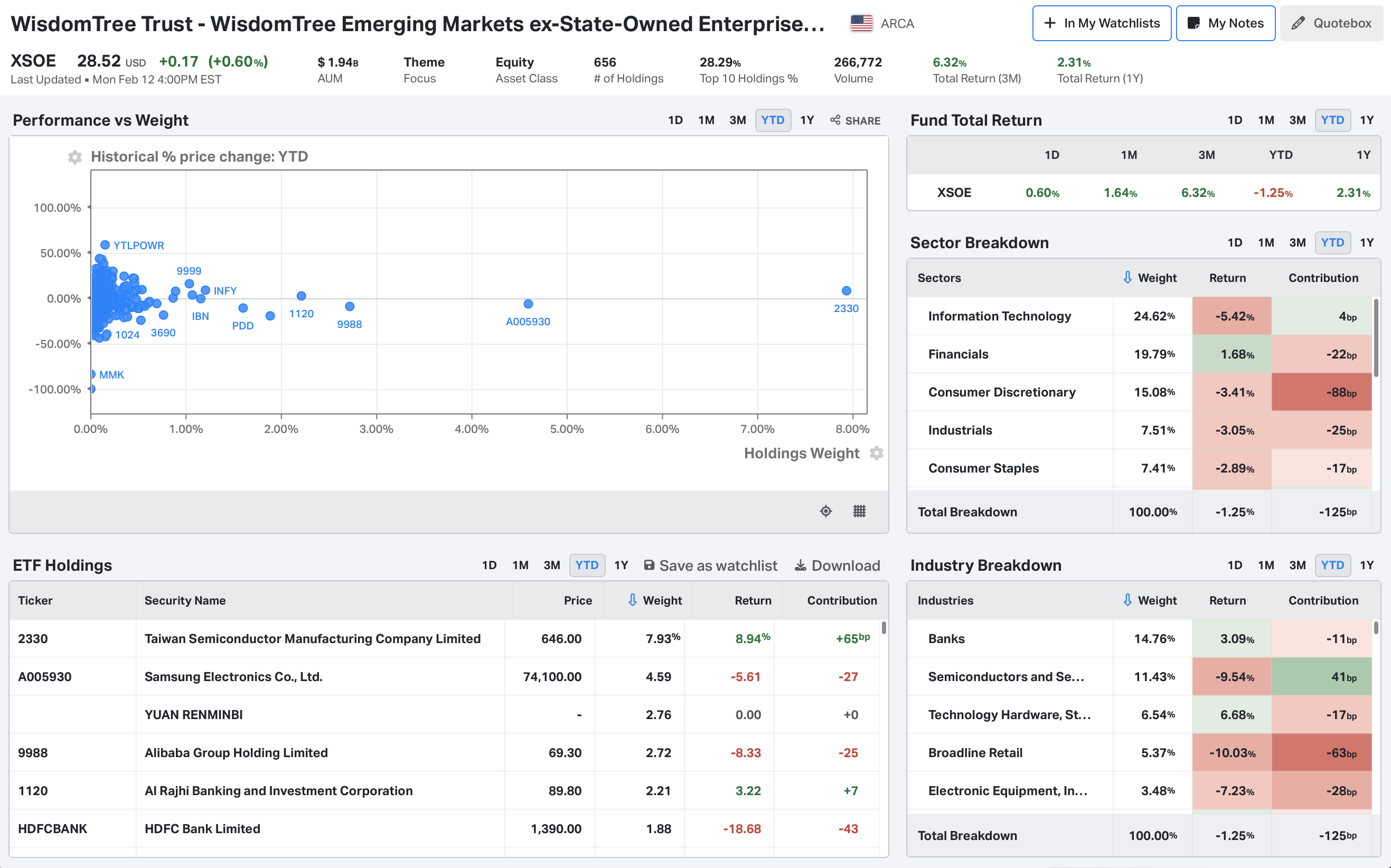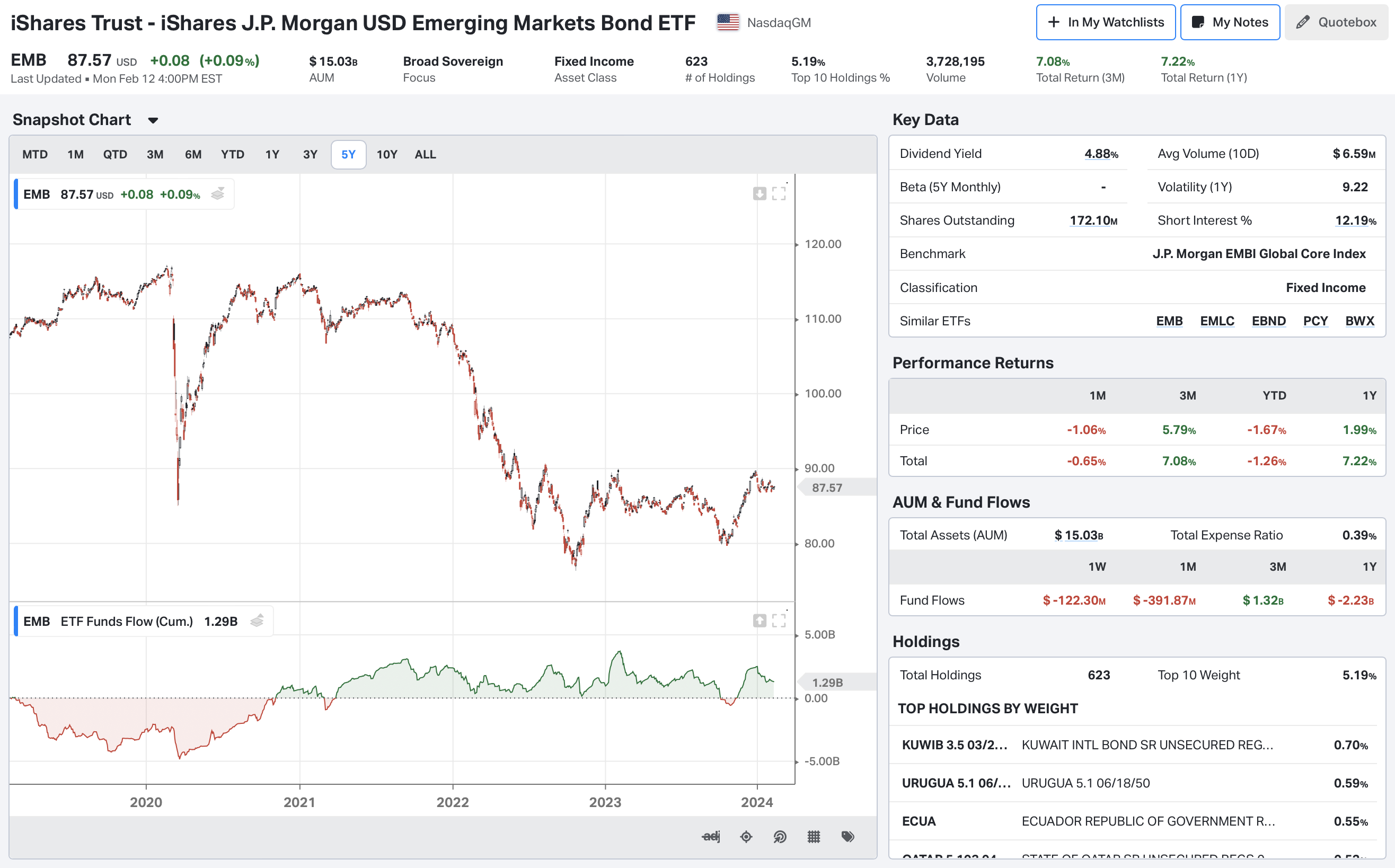8 Best Emerging Market ETFs
Investing in emerging markets offers growth opportunities, yet it comes with challenges. These markets, not fully developed but with significant potential, can be difficult for international investors due to barriers like limited brokerage access, unfamiliar accounting and regulatory landscapes, and cultural nuances. Emerging market investments often incur higher costs, including foreign exchange expenses, higher fund expense ratios, and increased risk. However, several ETFs now provide a more cost-effective way to gain exposure to these markets. These funds simplify the process, eliminating the need to select individual stocks in these regions and reducing the complexity and cost of investing in emerging markets.
PRO TIP:
When exploring emerging market ETFs, consider a range of criteria to ensure a well-rounded investment:
-
- Coverage Diversity: Choose ETFs that offer broad market coverage or specialize in specific countries or regions within emerging markets.
- Specialization and Asset Class: Look for funds that focus on particular aspects of emerging markets, like equities or bonds, to align with your investment goals.
- Cost-Effectiveness: Prioritize ETFs with lower costs to maximize your investment efficiency.
- Yield Potential: Consider ETFs with higher yield prospects if your investment strategy focuses on income generation.
- Liquidity: Ensure the ETFs you select have adequate liquidity for easier entry and exit.
Streamline Your ETFs Search
The Koyfin Screener allows scanning through more than 100K global securities using 5,900+ filter criteria. Set filters as mentioned in our Pro Tip to refine your search.
For those interested in other screening tools, the ‘Best Stock Screeners’ blog post offers a comparison to help find the perfect match.
*Data as of February 13th, 2024
Investing in emerging market ETFs involves more than initial selection; continuous monitoring is essential. Stay informed about global market trends, as they can significantly impact the performance of these ETFs. Additionally, keep an eye on political and economic developments in the specific regions or countries covered by the ETFs, as these factors can affect their stability and growth potential.
Track ETF Metrics in Koyfin Watchlists
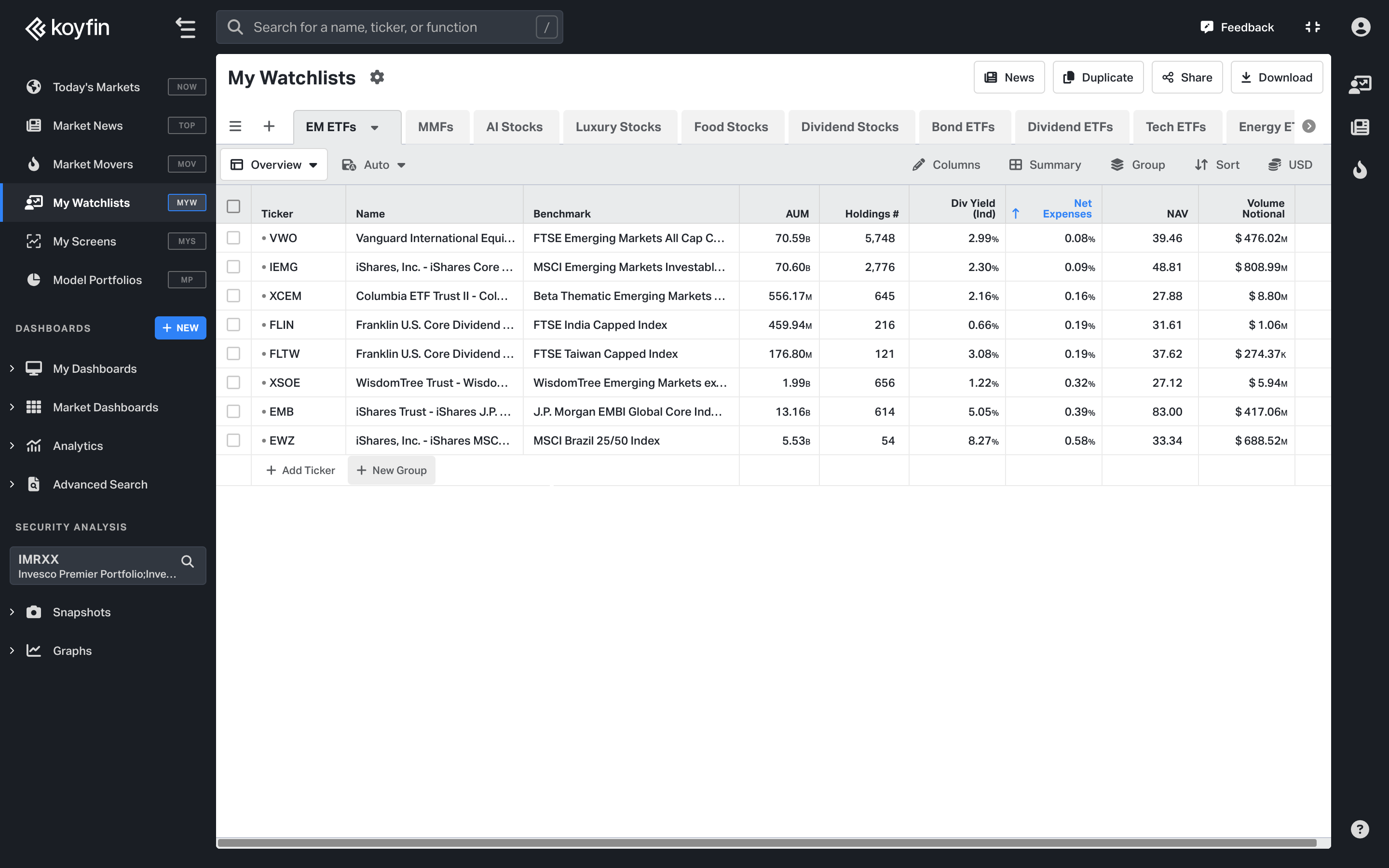
Vanguard FTSE Emerging Markets (VWO)
Starting off with the simplest, most liquid, and largest ETF in our list, the Vanguard FTSE emerging markets ETF offers investors exposure to more than 5,700 stocks across the world, primarily in countries like China, Brazil, India, Taiwan, Mexico, South Africa, and Saudi Arabia. Together, these seven countries account for 83% of the fund’s assets. China, with the largest weighting, accounts for 33%.
Among the ETFs that are strictly focused on equities in our list, VWO has the second-highest dividend yield at 3% and is the lowest-cost fund in our selection with a 0.08% expense ratio. Some of the largest holdings include companies such as Taiwan Semiconductor, Tencent Holdings, Alibaba, Reliance Industries, HDFC Bank, and Infosys. The sector composition of the fund is heavily weighted in financials (20%), information technology (16%), consumer discretionary (13%), and communication services (9%).
Launched in 2005, VWO has grown to $73.6 billion in AUM and offers investors a low cost, broad coverage of the emerging market universe, with an attractive dividend yield.
Key Investment Insights for Vanguard FTSE Emerging Markets (VWO):
Benchmark:
FTSE Emerging Markets All Cap China A Inclusion Index
AUM:
$73.6 billion
Number of Holdings:
5,737
Dividend Yield:2
.98%
Expense Ratio:
0.08%
Top 10 Weight:
18.85%
iShares Core MSCI Emerging Markets (IEMG)
The iShares Core MSCI Emerging Markets ETF is similar to VWO in that it offers a wide diversification across global emerging markets, but there are subtle differences. For starters, IEMG includes fewer stocks, at just over 2,700, and has a lower exposure to China, at 25% compared to VWO’s 33%. Other prominent countries include Taiwan, India, and South Korea. While many of the largest companies in IEMG are similar to those in VWO, the weightings differ slightly. The sectoral composition is very similar, weighted primarily in financials (20%), information technology (20%), consumer discretionary (13%), and communication services (9%).
Because IEMG focuses on core emerging markets and excludes some which are considered to be riskier, the dividend yield, 2.91%, is slightly less attractive, but the expense ratio remains cost effective at just 0.09%. The size of the fund, $72.8 billion, is also fairly large and similarly sized to VWO. This fund is ideal for an investor who wants exposure to emerging markets, but with a smaller basket of companies, focussed on only core emerging markets. We will note, however, that since the inception of IEMG, the total return performance of both IEMG and VWO has been similar, with VWO outperforming slightly. This does not indicate that this trend will continue, but it has shown that the increased diversification has not VWO’s return prospects in comparison.
Key Investment Insights for iShares Core MSCI Emerging Markets (IEMG):
Benchmark:
MSCI Emerging Markets Investable Market Index
AUM:
$73.56 billion
Number of Holdings:
2,967
Dividend Yield:
2.91%
Expense Ratio:
0.09%
Top 10 Weight:
19.75%
Columbia Trust EM Core ex-China (XCEM)
The Columbia Trust XCEM ETF is similar to IEMG but with one significant difference; it excludes exposure to companies domiciled in China and Hong Kong. Currently invested in 573 companies, the fund is more concentrated than the two we have shared previously and has a top 10 weighting of 29.8%. The fund permits a maximum number of holdings of 700 and invests primarily across Taiwan (24%), Korea (16%), India (12%), Saudi Arabia (9%), Brazil (8%), and UAE (6%). Some of the largest holdings include companies like Taiwan Semiconductor (9%), Samsung (6%), Saudi Arabian Oil (2%), AL Rajhi Bank (1%), and ITC (1%).
XCEM is more information technology-focused than VWO or IEMG, with a 30.5% weighting, as well as 27% exposure to financials, 9% to industrials and materials, and 7% in energy.
Launched in 2015, XCEM is one of the newer funds on our list and has amassed an AUM of $774.4 million so far. The dividend yield is 1.22% and the expense ratio is 0.16%. XCEM has notably outperformed IEMG and VWO over the last five years, and offers investors a more concentrated basket of emerging market companies with the exclusion of China and Hong Kong, which is a characteristic that some investors demand.
Key Investment Insights for Columbia Trust EM Core ex-China (XCEM):
Benchmark:
Beta Thematic Emerging Markets ex-China Index
AUM:
$774.44 million
Number of Holdings:313
Dividend Yield:1
.22%
Expense Ratio:
0.16%
Top 10 Weight:30
.46%
Franklin FTSE India (FLIN)
For investors who want exposure to a particular emerging market economy, there are a number of ETFs out there that cater to those demands. Franklin Templeton’s FTSE India ETF, FLIN, is one of them; providing targeted exposure to the large and mid-sized companies of India. There are several India ETFs in the market, but we chose one that has one of the lowest expense ratios and is well-rounded.
Some of the largest holdings include companies like Reliance Industries (8%), Infosys (5%), HDFC Bank (5%), Tata Consultancy (4%), Axis Bank (2%), and India Unilever (2%). The sector composition of the fund is heavily weighted in financials (22%), information technology (14%), consumer discretionary (11%), and materials (11%). India is home to fantastic companies, and the economy as a whole appears to have decades of growth ahead of it, with a rising middle class. This fund offers investors a low-cost (0.19% expense ratio) entry into the Indian market for those wishing to capture the growth of one of the world’s most promising emerging economies. The dividend yield of 0.71% is low, but the fund has more than made up for the lack of yield in recent years.
Something to note here is that FLIN is a smaller fund, at $736.4 million AUM. While it is lower cost than most funds on the market, this comes at the expense of greater liquidity. The iShares MSCI India ETF, for example, invests in 137 stocks (FLIN invests in 217) and has an AUM of $8.1 billion. However, in contrary fashion, INDA also has a higher expense ratio of 0.64% with an equally scant yield of 0.16%. These are the trade-offs you, as an investor, should be aware of.
Key Investment Insights for Franklin FTSE India (FLIN):
Benchmark:
FTSE India Capped Index
AUM:
$736.4 million
Number of Holdings:
216
Dividend Yield:
0.71%
Expense Ratio:
0.19%
Top 10 Weight:
33.68%
Franklin FTSE Taiwan (FLTW)
FTLW is Franklin Templeton’s Taiwan focused ETF. Similar to FLIN, FLTW offers investors more direct exposure to Taiwan, one of the world’s most promising emerging economies.
Some of the largest holdings include companies like Taiwan Semiconductor (20%), Hon Hai Precision (5%), MediaTek (4%), and Delta Electronics (3%). The sector composition of the fund is heavily weighted in information technology (60%) and financials (19%). The fund carries a dividend yield of 2.8% and owns 122 companies.
In a similar manner to FLIN and INDA, Franklin Templeton’s FLTW ETF is one of the lower cost Taiwan ETFs out there at 0.19% expense ratio. However, it’s also a very small fund with an AUM of just $189.2 million. Comparatively, we suggest investors looking for a more liquid fund with a similar makeup consider the iShares MSCI Taiwan ETF, EWT. EWT has a similar level of concentration with its holdings (Taiwan Semiconductor is 22% of EWT) and sectoral composition, but the AUM ($3.7 billion) and expense ratio (0.58%) are considerably higher.
Key Investment Insights for Franklin FTSE Taiwan (FLTW):
Benchmark:
FTSE Taiwan Capped Index
AUM:
$189.18 million
Number of Holdings:
122
Dividend Yield:2
.82%
Expense Ratio:
0.19%
Top 10 Weight:
45.4%
Wisdom Tree EM Ex-State Owned Enterprises (XSOE)
Emerging markets, by nature, can be home to politically unstable governments and/or styles of governance that are not accepted as desirable investment opportunities, by Western investors. The Wisdom Tree Ex-State Owned Enterprises ETF, XSOE, aims to invest in stocks of companies that are deemed socially conscious in their business dealings.
It does not invest in stocks that fail to comply with the United Nations Global Compact Principles related to human rights, labor, the environment and anti-corruption, are involved directly or through corporate ownership in the production and/or distribution of, or the provision of components/services for, controversial weapons, arms manufacture and sales related activities, the production and supply of tobacco-related products, oil and gas exploration activities in Arctic regions, oil sands extraction activities, shale energy exploration and/or production activities, or thermal coal-based power generation activities.
That was a mouthful. XSOE has a 25% weighting in China as well as larger exposure to India (20%), Taiwan (17%), South Korea (15%), and Brazil (4%), with a sectoral composition similar to VWO and IEMG, but with far fewer holdings, at just over 600. It has garnered some traction since its inception in 2014, amassing more than $1.9 billion in AUM, and currently has an expense ratio of 0.32% and a dividend yield of 1.81%; one of the smallest on our list. Investors might be scratching their heads on this ETF, when observing the country weightings, but I will remind you that the ETF is selective of the companies, not the countries in which they are domiciled. In some instances, a country like China may have state-ownership of some companies, while allowing other companies to operate independently.
Government-owned enterprises are typically inefficient and offer weaker growth potential because they are not run with the goal of exceeding investor expectations. They are run for the government and whichever purpose they might have. This ETF is therefore appropriate for investors who want emerging market exposure but without the influence of state-owned enterprises.
Key Investment Insights for Wisdom Tree EM Ex-State Owned Enterprises (XSOE):
Benchmark:
WisdomTree Emerging Markets ex-State-Owned Enterprises Index
AUM:
$1.94 billion
Number of Holdings:
656
Dividend Yield:
1.81%
Expense Ratio:
0.32%
Top 10 Weight:
28.29%
iShares JP Morgan USD EM Bond (EMB)
Our last entry are focused on emerging market bond ETFs. For more insight into bond ETFs, you might enjoy our 8 Best Bond ETFs of 2023 blog entry. The iShares JP Morgan EM Bond ETF invests in fixed income markets across emerging markets and primarily owns fixed and floating rate USD denominated debt issued by governments (85%), and government agencies (15%).
The fund invests in a variety of maturities with 60% of the debt maturing within 10 years, and 26% having a maturity of more than 20 years. The credit quality is mixed, with 23% of the assets being higher than A ratings, 27% BBB rated, 20% BB rated, 20% B rated, and the rest below CCC.
The fund has an AUM of $15 billion, an expense ratio of 0.39%, and a dividend yield of 4.9%. Bond ETFs like EMB offer an investor exposure to the fixed income side of emerging markets, as well as yield and diversification from their equity exposure in the region.
Key Investment Insights for iShares JP Morgan USD EM Bond (EMB):
Benchmark:
J.P. Morgan EMBI Global Core Index
AUM:
$15.03 billion
Number of Holdings:
623
Dividend Yield:4
.88%
Expense Ratio:
0.39%
Top 10 Weight:
5.19%
iShares MSCI Brazil (EWZ)
Sticking with the theme of country-specific ETFs, EWZ is the iShares MSCI Brazil ETF and is the largest on the market with an AUM of $5.6 billion. The fund invests in 55 of Brazil’s top companies and has a whopping 5.95% dividend yield and 0.58% expense ratio.
Some of the largest holdings include Vale SA (13%), Petroleo Brasilleiro (8%), Banco Bradesco (4%) and Localiza Rent a Car (3%). The fund is heavily invested in financials (25%) with a sizeable share in energy (19%), materials (18%) and industrials (10%).
One word of caution to investors looking to invest solely for the dividend. First, never do that; yield is not a great starting point for an investment. Second, the 10Y average yield of EWZ is closer to 4%; in recent years, the inflation has pushed up profits and dividends from energy companies, which are a large share of this fund.
Key Investment Insights for iShares MSCI Brazil (EWZ):
Benchmark:
MSCI Brazil 25/50 Index
AUM:
$5.61 billion
Number of Holdings:
56
Dividend Yield:5
.95%
Expense Ratio:
0.58%
Top 10 Weight:
56.21%
How to Create a Watchlist for Top Emerging Market ETFs
Step 1: Sign Up to Koyfin for Free. Register an account and get started; no credit card required.
Step 2: Create a Watchlist. Head to ‘My Watchlists’, create a new watchlist and give it a name.
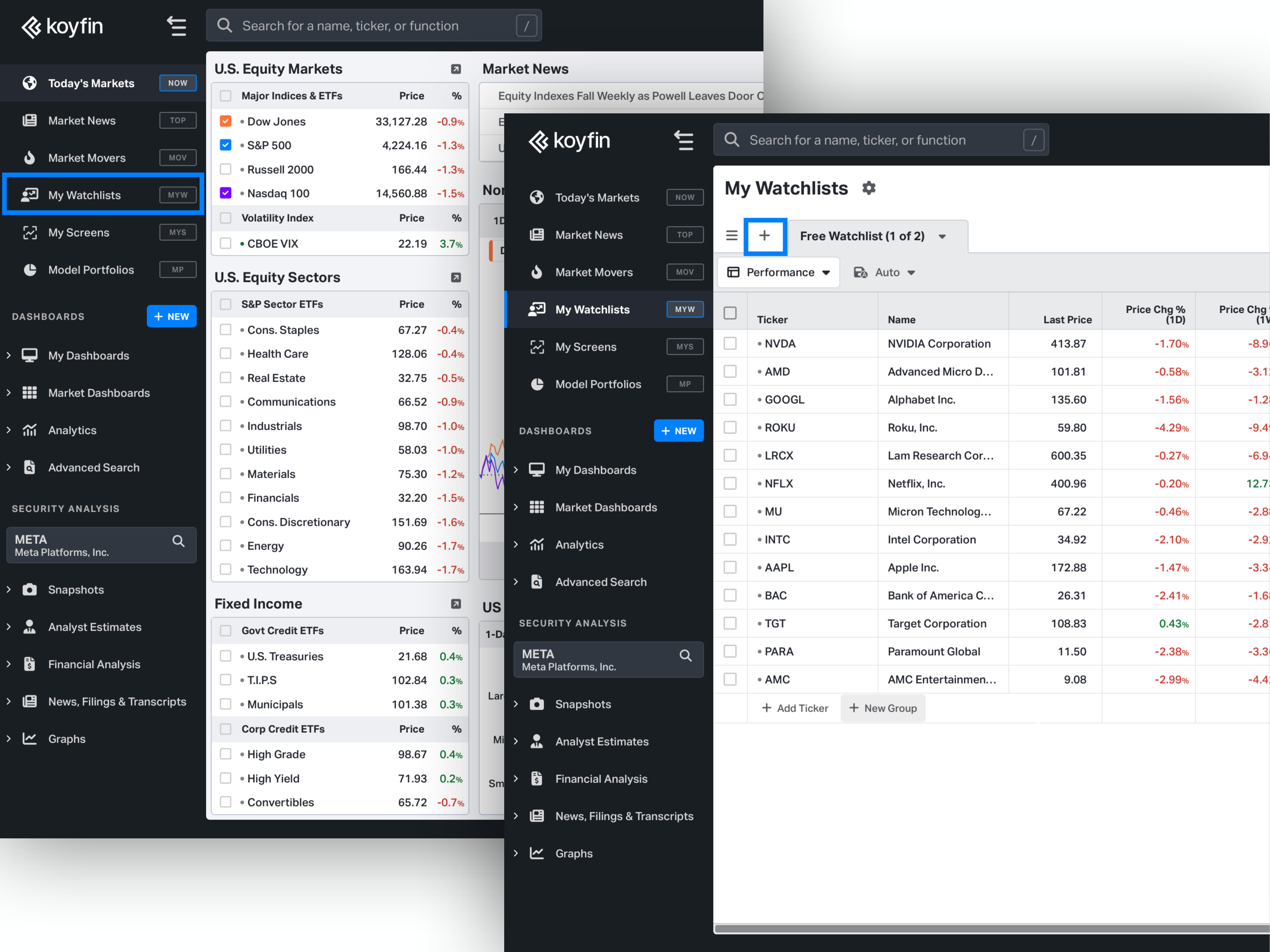
Step 3: Add Tickers. Click ‘Add Ticker’, then ‘Import Securities’, then copy and paste the below list of tickers.
VWO, IEMG, XCEM, FLIN, FLTW, XSOE, EMB, EWZ
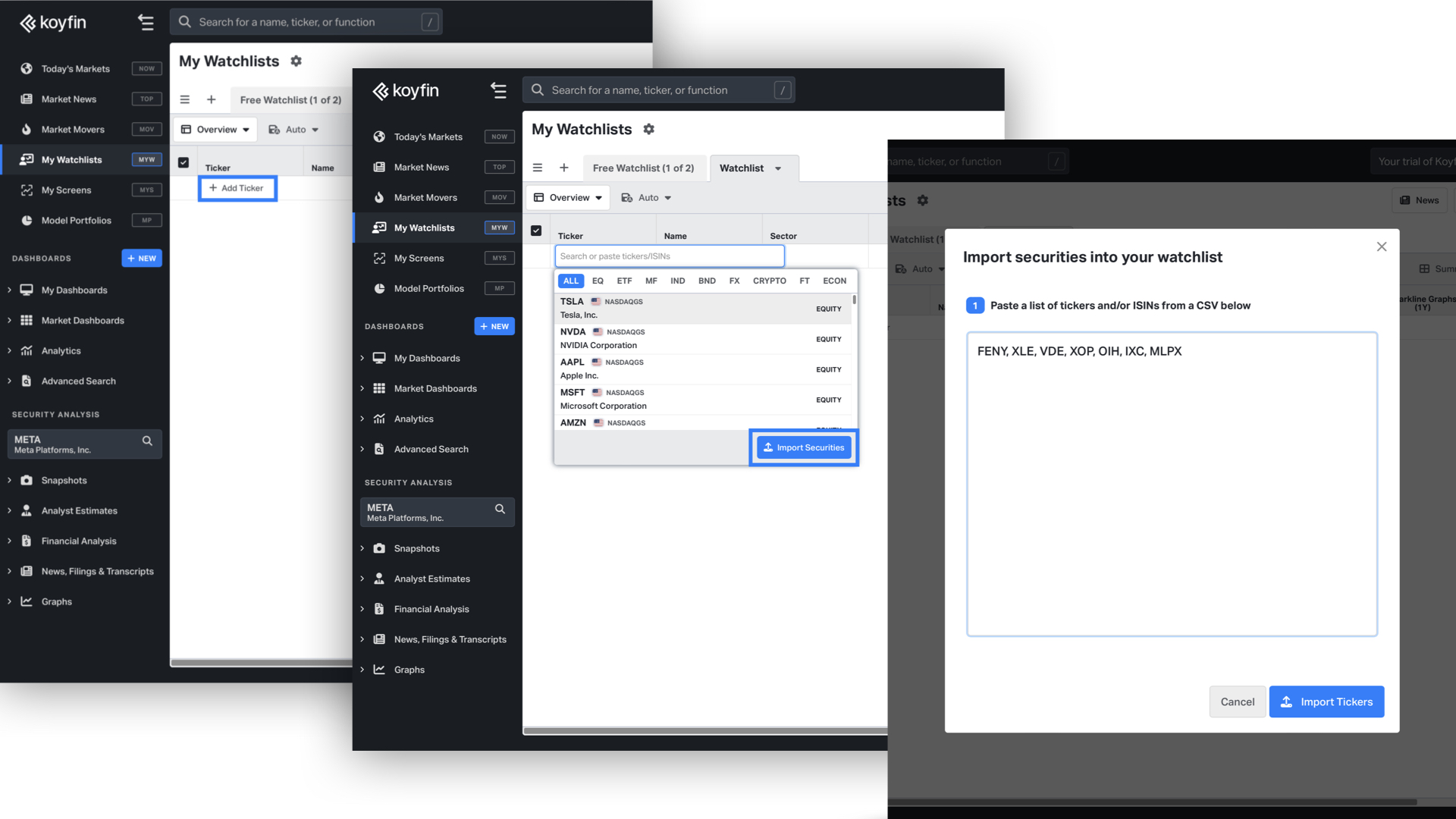
Step 4: Customize Columns. Hit the ‘Columns’ icon to add and remove columns from your watchlist table.
We have thousands of data points you can add to a watchlist, including fundamental data, price and returns data, analyst estimates, percentile ranks, security information, portfolio tools, and the ability to create your own formulas and labels.
Now your watchlist is ready, and you can use the rest of the Koyfin terminal to track and analyze these ETFs.
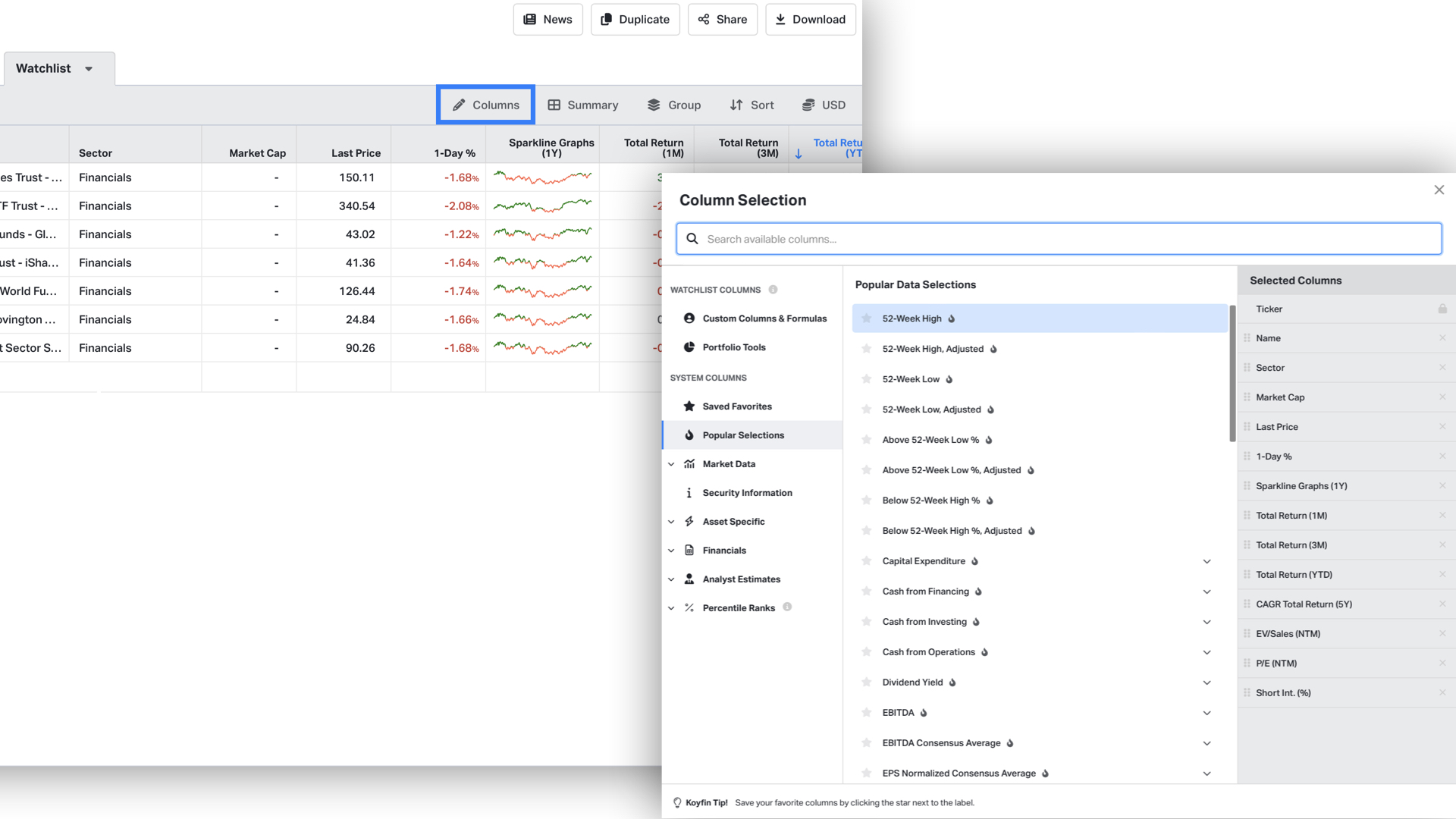
FAQ
-
What is an emerging market?
An emerging market refers to a country’s economy that is in the process of becoming a developed market due to its rapid growth and industrialization. These markets exhibit characteristics of developed markets but don’t meet all the criteria to be termed as such. They often have a stock exchange and a regulatory body in place, but may not be as advanced as those in developed markets. Investors are attracted to emerging markets because of the potential for high returns, though these come with increased risks due to political instability, currency volatility, and limited equity opportunities.
-
What regions or countries are typically included in an "Emerging Market" classification?
The regions or countries included in the “Emerging Market” classification can vary between ETF issuers. Some common examples include: Brazil, Chile, Colombia, Czech Republic, Egypt, Greece, Hungary, India, Indonesia, Kuwait, Malaysia, Mexico, Pakistan, Peru, Philippines, Poland, Qatar, Russia, Saudi Arabia, South Africa, South Korea, Taiwan, Thailand, Turkey, United Arab Emirates, and China. It’s important to note that while some classifications might include China and others might not, this list serves as a general reference based on typical categorizations.
-
Are Emerging Market ETFs more volatile than other types of ETFs?
Emerging Market ETFs typically exhibit higher volatility compared to ETFs focused on developed markets. This increased volatility stems from various factors such as political instability, currency fluctuations, and economic uncertainties in emerging countries. While they offer potential for higher returns due to rapid economic growth, they also come with a heightened risk profile. Investors and financial advisors should weigh these factors when considering their portfolio allocation.
-
How do these ETFs compare to developed market ETFs?
ETFs offer a diversified basket of assets, often tracking a specific index, theme, or sector. Quite simply, these ETFs differ because they grant exposure to emerging markets, while developed market ETFs focus on developed markets.
-
What are the benefits of investing in Emerging Market ETFs?
Diversification: Broaden your portfolio beyond domestic and developed markets.
Growth Potential: Access to fast-growing economies with potential for higher returns.
Cost-Efficiency: Lower expense ratios compared to many mutual funds.
Broad Exposure: Single purchase offers a wide range of companies and sectors across emerging countries.
Currency Diversification: Provides a hedge against potential domestic currency depreciation.
Ease of Access: Simplified entry into emerging markets, bypassing traditional barriers.
Editorial note
Our insights are derived solely from historical information and analyst predictions, employing an impartial approach. Please note that our articles do not serve as financial guidance.

